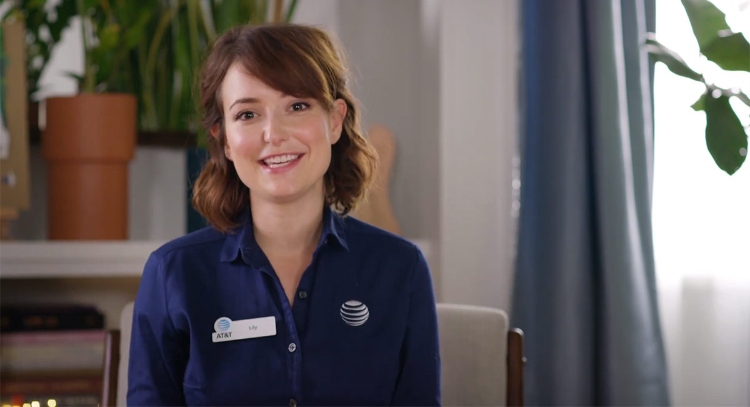
In the world of advertising, few characters have become as recognizable and beloved as Lily Adams, the friendly face of AT&T’s national commercial campaigns. Portrayed by actress Milana Vayntrub, Lily Adams became a symbol of charm, intelligence, and approachability—qualities that resonated with millions of viewers across the United States.
Milana Vayntrub first appeared as Lily Adams in 2013, and the character quickly gained popularity for her relatable personality and friendly demeanor. Unlike traditional commercials that often rely on exaggerated stereotypes or gimmicks, Lily Adams brought a grounded and modern presence to the screen.

Brand Impact and Audience Connection
Lily’s popularity extended beyond the commercials themselves.
Viewers appreciated how she represented a shift toward authentic, conversational marketing. AT&T’s decision to create a recurring character helped the brand foster long-term loyalty and trust with its customers.
This approach aligned with broader marketing trends in the 2010s, where storytelling and emotional connection became more effective than traditional hard-sell tactics. The campaign demonstrated how a well-developed character could make technical information about data plans and mobile coverage more engaging.
Who Is Milana Vayntrub?
Milana Vayntrub is more than just the face behind Lily Adams. Born in Tashkent, Uzbekistan (then part of the Soviet Union), Vayntrub and her family immigrated to the United States as refugees when she was a child.
She began acting at a young age and has appeared in numerous television shows and films, including roles in This Is Us, Silicon Valley, and Other Space.
In addition to her work in entertainment, Vayntrub is known for her advocacy and humanitarian efforts.
She co-founded the movement #CantDoNothing, which raises awareness for the global refugee crisis and encourages people to take positive action.

Evolving the Campaign: Behind the Scenes
AT&T’s advertising strategy evolved over time, especially in response to societal changes and the digital media landscape.
During the COVID-19 pandemic, the Lily Adams character reappeared in a series of commercials shot with safety protocols, often directed remotely by Vayntrub herself.
The brand acknowledged the character’s popularity by highlighting her return and adapting the content to reflect changing consumer needs. In an interview with Variety, Vayntrub discussed how she directed many of the pandemic-era ads from home, helping maintain brand consistency while respecting public health guidelines.

Managing Public Attention and Media Ethics
As the popularity of Lily Adams grew, so did public attention toward Milana Vayntrub.
While much of it was positive, she also experienced challenges with online harassment and inappropriate commentary, which she addressed openly on social media.
In 2020, Vayntrub shared a statement asking viewers and fans to respect boundaries and focus on her work, not speculative or objectifying content.
Media outlets and fans alike supported her call for digital respect and responsible engagement—a reminder of the human beings behind public personas.
AT&T responded by publicly supporting Vayntrub and emphasizing the importance of respectful online spaces.
The company reinforced its commitment to creating content that reflects positive representation and inclusivity.

Cultural Significance of a Commercial Icon
Lily Adams’ appeal transcends the boundaries of traditional advertising.
She became part of internet culture—appearing in memes, fan art, and discussion forums—often praised for her intelligence, authenticity, and the progressive tone she brought to tech marketing.
What makes the character unique is the lack of reliance on outdated tropes or oversexualized portrayals that historically dominated advertising.
Lily’s character was built around competence, clarity, and warmth, making her a positive figure for all audiences.

Looking Ahead: What’s Next for Milana Vayntrub?
While Vayntrub continues to be associated with Lily Adams, her career expands into other creative and socially impactful areas.
She voiced Squirrel Girl in Marvel’s animated series Marvel Rising and has expressed interest in continuing to work behind the camera as a writer and director.
Her advocacy work through #CantDoNothing remains active, encouraging action on refugee and immigrant support initiatives.
She also partners with organizations supporting women’s representation and mental health awareness in the entertainment industry.
Whether appearing on-screen or behind the scenes, Vayntrub’s influence continues to grow—both in advertising and in broader cultural conversations.

Conclusion: A New Standard in Advertising
Milana Vayntrub’s portrayal of Lily Adams is more than a successful ad campaign—it’s a case study in how advertising can evolve to meet the expectations of a modern audience.
Through relatable storytelling, inclusive messaging, and authentic performance, AT&T created a character that left a lasting impression.
Lily Adams represents the potential of marketing when it’s grounded in respect, relevance, and creativity.
For brands seeking to connect with today’s audiences, this campaign offers valuable lessons in character development, brand voice, and long-term audience engagement.
Sources and References:
- AT&T Official Commercials – YouTube
- Ad Age – AT&T’s Campaign Success
- Variety – Milana Vayntrub Discusses Directing During COVID-19
- Forbes – Milana Vayntrub’s Career and Advocacy
- BBC – Ethical Advertising and Digital Safety
- Harvard Business Review – Storytelling in Marketing
- Anti-Defamation League – Online Harassment
- Center for Humane Technology – Promoting Digital Well-being
- #CantDoNothing – Official Campaign Website